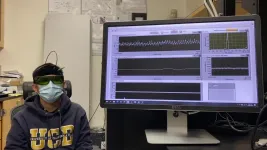(Press-News.org) An early study of a new experimental drug to treat obesity known as cagrilintide shows that, when combined with semaglutide 2.4 mg, the combination leads to more weight loss than semaglutide 2.4 mg alone and is well tolerated. This phase 1 study, which was recently published in The Lancet will be presented at this year's European Congress on Obesity (held online, 10-13 May) by Dr Lone Enebo, Novo Nordisk A/S, Denmark, on behalf of her colleagues. Novo Nordisk A/S is the manufacturer of both drugs in this study.
Combining medications with different modes of action may provide more effective treatment options for people with obesity. Weekly injections of cagrilintide, a newly-developed long-acting amylin analogue, in combination with semaglutide 2.4 mg, a glucagon-like peptide-1 (GLP-1) receptor agonist (already approved for type 2 diabetes), are both under clinical development for weight management. The efficacy and safety of semaglutide to treat obesity has been shown in the STEP trials, published across the past year.
This was a randomised, double-blind, placebo-controlled, phase 1 trial (NCT03600480) which took place in the USA to investigate the safety, tolerability, pharmacokinetics (PK), and pharmacodynamics (PD) of administration of six ascending doses of weekly cagrilintide (target dose levels of 0.16, 0.3, 0.6, 1.2, 2.4, or 4.5 mg) along with semaglutide 2.4 mg versus placebo and semaglutide 2.4 mg in subjects with overweight or obesity.
The 20-week trial included a 16-week escalation period (where subjects randomised to cagrilintide received progressively increasing doses up to the target dose levels) followed by a 4-week treatment period at target dose (there were 6 different target dose levels, one per cohort: 0.16, 0.3, 0.6, 1.2, 2.4, or 4.5 mg) and a 5-week follow-up.
Eligible subjects were male or female of non-childbearing potential, due to regulatory requirements at the time of study meaning women who could potentially become pregnant were excluded. Participants of the study were aged 18-55 years, with body mass index of between 27 and 40 kg/m² (ranging from having overweight to having severe obesity).
The primary endpoint was number of adverse events (AE) from baseline to follow-up. Secondary endpoints included PK of the drugs. In this early study, changes in body weight (an exploratory endpoint) were analysed separately for cagrilintide 0.16?2.4 mg + semaglutide 2.4 mg (vs pooled placebo). All participants received semaglutide 2.4 mg and ascending doses of cagrilintide or placebo.
Of 96 subjects randomised, 95 were exposed to treatment (59% male; mean age 40.6 years, body weight 95.7 kg, BMI 32.1 kg/m²) and 80 (83%) completed the trial. The number of AEs ranged from 37-89 with cagrilintide (0.16-4.5 mg) + semaglutide 2.4 mg and 132 with placebo + semaglutide 2.4 mg. In total, there were 566 AEs reported; most AEs were mild or moderate and the proportion of subjects with 1 or more AE was similar across treatment arms.
About one-third of all AEs were gastrointestinal (GI) disorders (n=207 of 566), primarily nausea, dyspepsia, and vomiting. A greater proportion of subjects reported GI AEs with cagrilintide 1.2-4.5 mg + semaglutide 2.4 mg compared to participants receiving placebo + semaglutide 2.4 mg. The second most common AEs were injection site reactions (n=72), all mild and not dependent on cagrilintide dose.
At week 20, body weight changes from baseline with cagrilintide 1.2 and 2.4 mg + semaglutide 2.4 mg (-15.7% and -17.1%) were greater than with placebo + semaglutide 2.4 mg (?9.8%) and with cagrilintide 4.5 mg + semaglutide 2.4 mg (-15.4%) vs matched placebo + semaglutide 2.4 mg (?8.0%) with all results reaching statistical significance.
The authors conclude: "Treatment with cagrilinitide at all tested doses in combination with semaglutide 2.4 mg was generally well tolerated with an acceptable safety profile. The data support once-weekly dosing. The combination of cagrilintide 1.2, 2.4, or 4.5 mg + semaglutide 2.4 mg led to greater weight loss compared with semaglutide 2.4 mg only."
They add: "As our data support the further clinical development of this drug combination for weight management, a phase 3 trial programme is now being planned to test cagrilinitide in combination with semaglutide for weight management."
INFORMATION:
Two-thirds of California prisoners who were offered a COVID-19 vaccine accepted at least one dose, according to a new study by researchers at the Stanford University School of Medicine.
"We found that many incarcerated people in California prisons were willing to be vaccinated for COVID-19," said Elizabeth Chin, the lead author of the study and a PhD candidate in biomedical data science. "This is an encouraging sign for other states at an early stage of rolling out vaccination programs in their prisons and jails."
The researchers also found that nearly half of those who initially turned down a COVID-19 vaccine accepted it when it was offered to them again. The finding is an important indication that vaccine hesitancy is not necessarily fixed.
Two-thirds ...
The 1949 letter by the physicist and Nobel laureate discusses bees, birds and whether new physics principles could come from studying animal senses.
It's a position still being realised within physics to this day, with a growing body of research and understanding of how animals such as birds and bees find their way around.
Now a study led by RMIT University in Melbourne, Australia, discusses how recent discoveries in migratory birds back up Einstein's thinking 72 years ago.
The previously unpublished letter was shared with researchers by Judith Davys - Einstein had addressed ...
If you did not catch the flu this year -- and there is an overwhelming chance that you did not -- you have COVID-19 to thank.
It's a small consolation, given the enormously disruptive scope of the pandemic. But it's the focus of a new paper published in the journal Frontiers in Public Health by two Concordia researchers and their colleagues that studies the 2020 influenza figures from Canada, the United States, Australia and Brazil. The authors show there is a clear relationship between the implementation of COVID-mitigation measures such as hand-washing, masking and social distancing and the spread of the annual flu.
They write that these preventive measures all but eliminated ...
The quest to create safer, more successful pregnancies is one of the top goals of modern science. While pregnancy is better understood today than ever before, with improvements in technology helping to lower the risk of negative outcomes, there is much researchers still don't know about a vital part of the pregnancy process: uterine fluid.
Secreted by glands in the uterus during pregnancy, uterine fluid is believed to play an important role in supporting a developing embryo by sending information from the uterus to the embryo, along with a host ...
In 2020, stores sold out of garden seed, coops and rabbit cages. Now, we have an idea how much protein people can grow in their backyards.
The 2020 meat shortages led many to wonder what to eat for protein when supply chains are disrupted. Some people turned to gathering eggs, raising animals and growing their own food. A team from Michigan Technological University and the University of Alaska Fairbanks found that the work is well worth it. In a new study published in Sustainability, the researchers looked at how a typical household with a typical backyard can raise chickens, rabbits or soybeans to meet its protein needs.
People eat a lot of protein in the U.S. and the average person needs 51 grams of ...
MINNEAPOLIS/ST.PAUL (05/12/2021) -- In a study recently published in END ...
DURHAM, N.H.-- A national report from the University of New Hampshire shows close to one and a half million children each year visit a doctor, emergency room or medical facility as a result of an assault, abuse, crime or other form of violence. This is four times higher than previous estimates based only on data from U.S. emergency rooms for violence-related treatment.
In their END ...
A portable, rapid testing platform can detect gonorrhea infections in patient samples in under 15 minutes, far faster than standard-of-care tests that can take hours or days. The platform accurately detected infections and determined resistance to a common antibiotic in 217 patient samples from sexual health clinics in Baltimore and Uganda. The technology's speed and low cost could empower quicker and more affordable gonorrhea testing in low-resource regions, as well as help combat the spread of drug-resistant strains. Rates of gonorrhea and other sexually transmitted ...
A new, noninvasive method for measuring brain blood flow with light has been developed by biomedical engineers and neurologists at the University of California, Davis, and used to detect brain activation. The new method, functional interferometric diffusing wave spectroscopy, or fiDWS, promises to be cheaper than existing technology and could be used for assessing brain injuries, or in neuroscience research. The work is published May 12 in Science Advances.
"Now we can assess how well the brain regulates blood flow, and even detect brain activation noninvasively in adult humans, using principles similar to functional ...
MISSOULA - Only an anthropologist would treasure millennia-old human feces found in dry caves.
Just ask Dr. Meradeth Snow, a University of Montana researcher and co-chair of UM's Department of Anthropology. She is part of an international team, led by the Harvard Medical School-affiliated Joslin Diabetes Center, that used human "paleofeces" to discover that ancient people had far different microorganisms living in their guts than we do in modern times.
Snow said studying the gut microbes found in the ancient fecal material may offer clues to combat diseases like diabetes that afflict people living in today's industrialized societies.
"We ...





